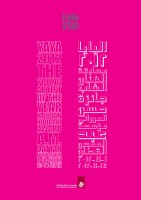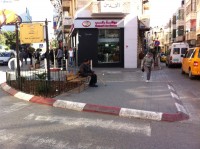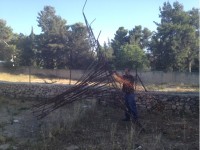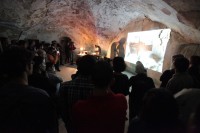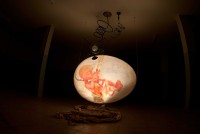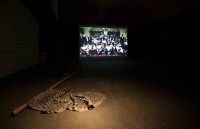Young Artist of the Year Award YAYA (2012)
co-curated with Reem Shilleh
also production coordinator and graphic designer.
Commissioned by A.M. Qattan Foundation to curate the 7th edition of the YAYA as part of Qalandia International (Q.I.)
Visit the YAYA12 blog here
the exhibition was also shown at the Mosaic Rooms London in 2013.
------
Oscillation Between Two Presents
Reem Shilleh and Yazan Khalili
September 2012 – June 2013
Prologue
This is a collection of fragments of texts written over a period of ten months, beginning with the early stages of the production phase of the YAYA 2012 up to the very day when the last word of this text was written/edited. After a number of failed attempts to produce a contribution to the YAYA 2012 catalogue, it became clear that what was needed was to oscillate between the two different presents: the present of the YAYA 2012 – i.e. the production and exhibition phase – and the present of the YAYA 2012 catalogue.
So we oscillated:
3.
We were conscious since the very beginning of the impossibility of curating an exhibition such as the YAYA exhibition. The artists and their projects have already been selected. Our role was, rather, to help the artists in the production of their artworks, to create suitable conditions for the works to be presented in and to organise and coordinate the YAYA as an event.
2.
You brought up the subject of the bench that was removed from the pavement across from the Rukab Ice Cream shop quite a few times. The bench was designed by ShamsArd Design Studio as part of the Routes, 1 the Furniture Route, which we invited them to design. The bench was relocated in the garden of the Ottoman Court, a renovated 18th century house. You suggested that we build our text around this bench.
4.
It is interesting, the issue of removal. It contains a practice of violence within it, a violence to the object removed and to the space that contained it. But this removal implicates the object and the space in another condition, that of displacement.2
13.
“To curate a body of works that have so little in common is a challenging venture, or even – somehow – impossible. When the finalist projects of the Young Artist of the Year Award, the YAYA, are selected, apart from being promising ideas for an artwork, the only thread that binds them together are their makers. The makers, or the “young artists”, are required to fit within a certain age group, and either are of Palestinian descent or come from the Occupied Golan Heights. But the artworks exist in complete autonomy from each other; there is not one single theme/concept to hold them together. Each work resides in a universe of its own.”
5.
The institution had its own concern: how to have a successful event? This concern was placed in our laps. How to define success in the case of YAYA 2012? Well-produced artworks? The choice of exhibiting spaces? Or is it the number of visitors and the public interaction with the exhibition? Is it the leftovers of the event, the publications, blogs, media coverage, reviews? Or the knowledge and experience that the young artists take away with them? The experience that is left in the community, if any? Is it all of these? How can these multiple layers and elements be contained in one single exhibition?
1.
We had other concerns:
“This blog3 is an attempt at creating a context for exposing the knowledge that is created during the process of artwork production. It [the blog] is assumed to act as a space in which the artists and their works are in continuous conversation with each other, a space for tracing development, conceptually and technically, a means for recording changes by looking into the elements and factors that affect the making of the work, how concepts bend to the force of technical/spatial/time challenges and vice-versa. In other words, the blog is an attempt at recording the accumulation of knowledge gained during a very specific period of production as a testimony to what was prior to the final artwork and the exhibition opening.”
7.
I looked it up. According to Freudian psychoanalytic theory, displacement is when a person shifts her/his impulses from an unacceptable target to a more acceptable or less threatening target. “The explanation is that the displacement which replaces psychically important by indifferent material (alike in dreaming and in thinking) has in these cases already taken place at the early period of life in question and since then become fixed in the memory4.” I found this really interesting in relation to the removal of the objects from public space. Is this removal an act of displacement? Or were they a signifier for an altogether different displacement? Was it a form of displacement at all?
6.
I remembered another ‘removal’, also from the public sphere. A while back, some months after the end of the YAYA 2012 exhibitions, one of the participating artists contacted me about the blog we put up during the period leading to the exhibition and the finalising of the artworks. She requested that we remove her contributions to the blog because she no longer felt that they were relevant to the project as it is today, and that they do not fit the context in which the artwork exists at the moment. She simply felt uncomfortable that so much was revealed about the project and that in some ways the artwork was stripped of intimacy. The request was respected and her contributions were removed. But I felt that something had to stay behind, a remnant.
8.
While thinking about writing this text I was drawn to the recent past and a presentation I attended in Beirut. A collective of performers, thinkers and filmmakers were presenting their recent publication and film, which was particularly interesting to me because it was made of archival material and archive shamelessly seduces and disarms me. But they talked about the public space and the performance of the collective body in this space as dominated and ‘choreographed’ by socialist ideology and the transformations of this ideology over a period of a few decades which ended in absolute decadence and a form of violence. Questions were raised on what followed afterwards. How did the public performance of the collective body mutate? The country was invaded by a neo-liberal economy, of course, which claims that it is non-ideological, that it is by no means nested in some sort of demagogic structure, that it is entirely apolitical. I remembered Ramallah, its public space, the collective body, the rules of public performance. I thought of Ramallah during the period of the First Intifada and I thought of Ramallah following the Oslo period. Today, we, the collective body, perform to the rules of that ideology which is pretentiously in denial: neo-liberalism. And then I remembered the YAYA routes. Were they some sort of a reclaiming of the public space, or asking the collective body to reclaim this space. Oh, how naïve!
11.
Photo below #11
Photography by: Yazan Khalili, Ramallah, 2013
9.
The removal of the bench wasn’t a total surprise. The Municipality clearly stated from the very beginning of the inter-institutional negotiations that they would study our request to keep the street furniture that was designed for the Furniture Route. They said they would think about it. In the end, they kept some and removed others.5 They also removed the bus stops that were part of the Servees Route. The reason I thought of the removal of the bench as displacement is because the Municipality said this bench had become a place where young men would hang out and harass women. The owners of the surrounding shops had complained and two weeks after the end of the YAYA exhibitions it was removed. I visited the bench once while it was still there and an old man was sitting there resting, in the downtown area where there is no place to rest. The only place one can do that is in a café or a restaurant, where one has to buy something to be allowed to sit there. For the Municipality, it is much easier to confront this old man than the issue of harassment and the power of the shop owners. But where does this fit in the artworks that were presented in the exhibition? Do they hold that displacement within them? In their relation with the bigger audience? In the afterlife of the artwork?
15.
Is the artist, as a practitioner of contemporary art, trying to break/escape the structures bounded to the classical art form and practice by taking it to a place where it can freely express itself through ambiguity, nonlinearity and abstraction? Isn’t it there where cinema can become video art, looping without a beginning or an end, where the viewer can come in and out at any point and read it the way s/he wants? Doesn’t this remove the confrontational moment with the artist? Or does it shift it to a safer zone? Aren’t all displaced: the artist, the artwork and the viewer?
10.
My hand dug into my bag searching for my camera. I had forgotten it at home, as usual. But this was what I wanted the picture to capture:
the same pavement facing Rukab Ice Cream shop. At the same exact spot where the bench had been, three youths were leaning on the loose chains that connected the two poles 6 against which the bench was placed. They were hanging out and watching people and cars pass by. I smiled to myself: I wonder what pick up lines they were throwing at the girls passing in front of them.
14.
Maybe an exhibition has to address these issues every time it is actualised; it has to be able to bring the different aspects together in order to succeed in doing its main task: to create a context for its existence? But then again, this is a dominant and institutional discourse, very pedagogical, very patriarchal. What an exhibition needs to do, in the case of institutional art exhibiting, is to display to the public the knowledge that this institution contains and to ensure its power through this display; to provide, but also to appropriate those to whom they provide.
12.
Photo below #12
Photography by: Danna Masad, Ramallah, 2013
1 The Routes were spatial and social interventions in the public space of Ramallah. Three different artist/designer/street artist groups were approached and asked to think of ways to take the YAYA out to the wider public. Each group came up with designs for a unique route that would connect the exhibition venues and potentially lead the public from one venue to another. There were three routes: The Furniture Route, The Graffiti Route and The Servees Route. You can read more about them starting from page 34.
2 Recently I was listening to a professor in Berlin (I can’t remember her name) proposing that contemporary art is actually a state of displacement: displaced poetry, literature, philosophy, politics, painting, photography, etc.
3 http://youngartist2012.blogspot.com
We thought about bringing the exhibition to a wider audience, firstly by creating a blog that exposes the process of production, where each artist responded to certain questions that we sent every week or two weeks. The aim was to expand the place and the time duration of the exhibition, and to involve the artists in this expansion. The blog wasn’t a big success, not many people read it, but it created a declaration of some sort, a notification that something is being cooked, something will be exhibited soon.
4 Sigmund Freud, The Interpretation of Dreams, The Complete and Definitive Text, translated and edited by James Strachey, New York: Basic Books, 2010, p. 205
5 I forgot about another removal. You were absent when this one happened. It was an umbrella-like structure made out of wire that was placed in the centre of a very large tire; it was meant to have a climbing plant grow around it so it provided shade for passersby to sit under. It was placed in the Clock Square (which now, by the way, is called Yasser Arafat Square). We received a phone call from the Municipality to ask us to remove the structure ASAP in order to clear space for the forthcoming ‘popular’ support for Abu Mazen’s bid to the UN to recognise ‘Palestine’ as a non-member observer ‘state’. We were asked to immediately clear the stage for a widely attended farce. I was teleported back to my thoughts at the Metropolis Cinema in Beirut and the rules of public performativity.
6 These pole/chain combinations replaced more solid metal railing structures that used to line the pavements of downtown Ramallah. A few years ago, the downtown area underwent drastic renovations, leaving that part of the city almost unrecognisable, picturesque and foreign.
